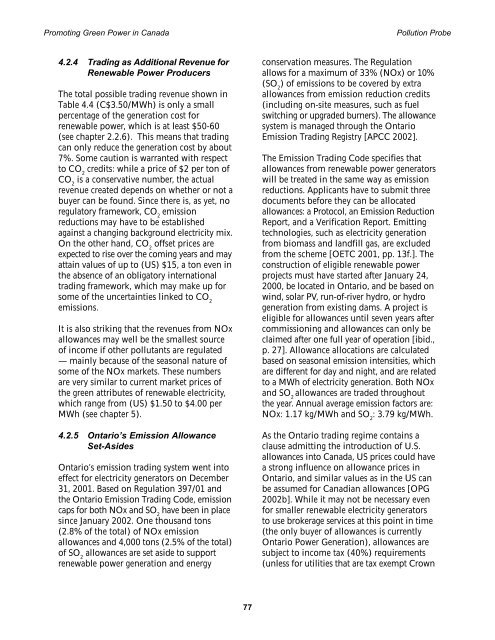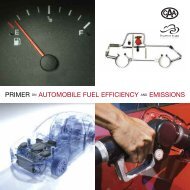Promoting Green Power in Canada - Centre for Human Settlements
Promoting Green Power in Canada - Centre for Human Settlements
Promoting Green Power in Canada - Centre for Human Settlements
- No tags were found...
You also want an ePaper? Increase the reach of your titles
YUMPU automatically turns print PDFs into web optimized ePapers that Google loves.
<strong>Promot<strong>in</strong>g</strong> <strong>Green</strong> <strong>Power</strong> <strong>in</strong> <strong>Canada</strong> Pollution Probe4.2.4 Trad<strong>in</strong>g as Additional Revenue <strong>for</strong>Renewable <strong>Power</strong> ProducersThe total possible trad<strong>in</strong>g revenue shown <strong>in</strong>Table 4.4 (C$3.50/MWh) is only a smallpercentage of the generation cost <strong>for</strong>renewable power, which is at least $50-60(see chapter 2.2.6). This means that trad<strong>in</strong>gcan only reduce the generation cost by about7%. Some caution is warranted with respectto CO 2credits: while a price of $2 per ton ofCO 2is a conservative number, the actualrevenue created depends on whether or not abuyer can be found. S<strong>in</strong>ce there is, as yet, noregulatory framework, CO 2emissionreductions may have to be establishedaga<strong>in</strong>st a chang<strong>in</strong>g background electricity mix.On the other hand, CO 2offset prices areexpected to rise over the com<strong>in</strong>g years and mayatta<strong>in</strong> values of up to (US) $15, a ton even <strong>in</strong>the absence of an obligatory <strong>in</strong>ternationaltrad<strong>in</strong>g framework, which may make up <strong>for</strong>some of the uncerta<strong>in</strong>ties l<strong>in</strong>ked to CO 2emissions.It is also strik<strong>in</strong>g that the revenues from NOxallowances may well be the smallest sourceof <strong>in</strong>come if other pollutants are regulated— ma<strong>in</strong>ly because of the seasonal nature ofsome of the NOx markets. These numbersare very similar to current market prices ofthe green attributes of renewable electricity,which range from (US) $1.50 to $4.00 perMWh (see chapter 5).4.2.5 Ontario’s Emission AllowanceSet-AsidesOntario’s emission trad<strong>in</strong>g system went <strong>in</strong>toeffect <strong>for</strong> electricity generators on December31, 2001. Based on Regulation 397/01 andthe Ontario Emission Trad<strong>in</strong>g Code, emissioncaps <strong>for</strong> both NOx and SO 2have been <strong>in</strong> places<strong>in</strong>ce January 2002. One thousand tons(2.8% of the total) of NOx emissionallowances and 4,000 tons (2.5% of the total)of SO 2allowances are set aside to supportrenewable power generation and energyconservation measures. The Regulationallows <strong>for</strong> a maximum of 33% (NOx) or 10%(SO 2) of emissions to be covered by extraallowances from emission reduction credits(<strong>in</strong>clud<strong>in</strong>g on-site measures, such as fuelswitch<strong>in</strong>g or upgraded burners). The allowancesystem is managed through the OntarioEmission Trad<strong>in</strong>g Registry [APCC 2002].The Emission Trad<strong>in</strong>g Code specifies thatallowances from renewable power generatorswill be treated <strong>in</strong> the same way as emissionreductions. Applicants have to submit threedocuments be<strong>for</strong>e they can be allocatedallowances: a Protocol, an Emission ReductionReport, and a Verification Report. Emitt<strong>in</strong>gtechnologies, such as electricity generationfrom biomass and landfill gas, are excludedfrom the scheme [OETC 2001, pp. 13f.]. Theconstruction of eligible renewable powerprojects must have started after January 24,2000, be located <strong>in</strong> Ontario, and be based onw<strong>in</strong>d, solar PV, run-of-river hydro, or hydrogeneration from exist<strong>in</strong>g dams. A project iseligible <strong>for</strong> allowances until seven years aftercommission<strong>in</strong>g and allowances can only beclaimed after one full year of operation [ibid.,p. 27]. Allowance allocations are calculatedbased on seasonal emission <strong>in</strong>tensities, whichare different <strong>for</strong> day and night, and are relatedto a MWh of electricity generation. Both NOxand SO 2allowances are traded throughoutthe year. Annual average emission factors are:NOx: 1.17 kg/MWh and SO 2: 3.79 kg/MWh.As the Ontario trad<strong>in</strong>g regime conta<strong>in</strong>s aclause admitt<strong>in</strong>g the <strong>in</strong>troduction of U.S.allowances <strong>in</strong>to <strong>Canada</strong>, US prices could havea strong <strong>in</strong>fluence on allowance prices <strong>in</strong>Ontario, and similar values as <strong>in</strong> the US canbe assumed <strong>for</strong> Canadian allowances [OPG2002b]. While it may not be necessary even<strong>for</strong> smaller renewable electricity generatorsto use brokerage services at this po<strong>in</strong>t <strong>in</strong> time(the only buyer of allowances is currentlyOntario <strong>Power</strong> Generation), allowances aresubject to <strong>in</strong>come tax (40%) requirements(unless <strong>for</strong> utilities that are tax exempt Crown77
















